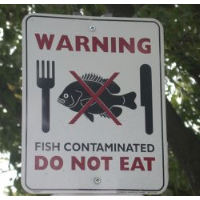State Warns Women and Kids to Skip Mercury-Tainted Fish in California Lakes

When it comes to dining in California, Robert Brodberg, lead fish toxicologis at the state Office of Environmental Health Hazard Assessment (OEHHA), passed this piece of advice along to the Los Angeles Times: “We'd like to move people away from the fish that are higher in contaminants and toward those that are lower.”
Good idea. To that end, the state has posted a statewide advisory (pdf) that women of child-bearing age and children should stop eating bass, carp and large brown trout caught in state lakes and reservoirs because of excessive methylmercury. Women over 45 and men can eat those fish once a week. Women 18–45 and kids can eat rainbow trout twice a week, while women over 45 and men can chow down on it six out of seven days.
Children and women 18–45 can eat one serving per week of bullhead, catfish, bluegill or small brown trout (16 inches or shorter). Women older than 45 and men can have up to two servings per week.
Mercury-tainted fish have been a concern in California for years. Dozens of lakes, rivers, bays and stretches along the coast have all been subject to local advisories, but the warning released this week by the OEHHA is the first statewide and there is no mention of a time factor.
OEHHA scientists evaluated data from 272 lakes and reservoirs, along with tissue samples from 2,600 fish, for the study. Fish aficionados can consult the state’s official Fish Advisories and Safe Eating Guidelines for specific advice on where the most likely places are to acquire mercury poisoning.
Mercury is a toxic metal that builds up in the flesh of fish and humans. It can damage the kidney, brain and nervous system, and is easily passed to a fetus by its mother. The main source of mercury in California lakes and reservoirs is past gold and other mining activities. But burning coal, waste incineration and general global air pollution are also prominent contributors.
California is not the only place where you can easily exceed the recommended limit of mercury-tainted fish. The Biodiversity Research Institute and the International POPs Elimination Network (IPEN) released a report (pdf) in January which found that 84% of the world’s fish contain what they consider unsafe levels of mercury.
–Ken Broder
To Learn More:
High Mercury Levels Prompt Fish Consumption Warning (by Janet Zimmerman, Riverside Press-Enterprise)
Women, Kids Urged to Avoid Mercury-Tainted Fish from California Lakes (by Tony Barboza, Los Angeles Times)
Statewide Health Advisory for Eating Fish from California’s Lakes and Reservoirs without Site-Specific Advice (California Office of Environmental Health Hazard Assessment) (pdf)
Global Mercury Hotspots Media Library (Biodiversity Research Institute)
14% of Mercury in Great Lakes Comes from China . . . but the Largest Source Is Nearby Coal-Fired Power Plants (by Noel Brinkerhoff, David Wallechinsky, AllGov)
- Top Stories
- Controversies
- Where is the Money Going?
- California and the Nation
- Appointments and Resignations
- Unusual News
- Latest News
- California Forbids U.S. Immigration Agents from Pretending to be Police
- California Lawmakers Urged to Strip “Self-Dealing” Tax Board of Its Duties
- Big Oil’s Grip on California
- Santa Cruz Police See Homeland Security Betrayal in Use of Gang Roundup as Cover for Immigration Raid
- Oil Companies Face Deadline to Stop Polluting California Groundwater





